Museum

A museum, known as Muzeum Martyrologii Pod Zegarem (The Museum of the Martyrology of Under the Clock) was established there to remember Polish history and the people who died at Under the Clock. [3]
Under the Clock (Pod Zegarem in Polish) was a Nazi torture centre in Lublin, Poland during World War II.
The Nazis used Lublin as the center of Operation Reinhard. The torture centre is in the centre of the city nearby a clock tower. Gestapo established cells in the basement and used them to interrogate Poles. [1] [2] It was used by the Nazis from 1939 - 1944.

A museum, known as Muzeum Martyrologii Pod Zegarem (The Museum of the Martyrology of Under the Clock) was established there to remember Polish history and the people who died at Under the Clock. [3]
Under the Clock serves as a plot location in James A. Michener's novel Poland .

Lublin is the ninth-largest city in Poland and the second-largest city of historical Lesser Poland. It is the capital and the centre of Lublin Voivodeship with a population of 336,339. Lublin is the largest Polish city east of the Vistula River and is about 170 km (106 mi) to the southeast of Warsaw by road.

Majdanek was a Nazi concentration and extermination camp built and operated by the SS on the outskirts of the city of Lublin during the German occupation of Poland in World War II. It had seven gas chambers, two wooden gallows, and some 227 structures in all, placing it among the largest of Nazi concentration camps. Although initially intended for forced labor rather than extermination, it was used to murder people on an industrial scale during Operation Reinhard, the German plan to murder all Polish Jews within their own occupied homeland. In operation from 1 October 1941 to 22 July 1944, it was captured nearly intact. The rapid advance of the Soviet Red Army during Operation Bagration prevented the SS from destroying most of its infrastructure, and Deputy Camp Commandant Anton Thernes failed to remove the most incriminating evidence of war crimes.

Łęczna is a town in eastern Poland with 19,780 inhabitants (2014), situated in Lublin Voivodeship. It is the seat of Łęczna County and the smaller administrative district of Gmina Łęczna. The town is located in northeastern corner of historic province of Lesser Poland. Łęczna tops among the hills of the Lublin Upland, at the confluence of two rivers—the Wieprz, and the Świnka. On December 31, 2010, the population of the town was 20,706. Łęczna does not have a rail station, the town has been placed on a national Route 82 from Lublin to Włodawa. And shall be considered as a start point to Kameralne Pojezierze, as the town has decided to rebrand the lakeland district, from Pojezierze Łęczyńsko-Włodawskie, or Pojezierze Łęczyńskie, to Kameralne Pojezierze.
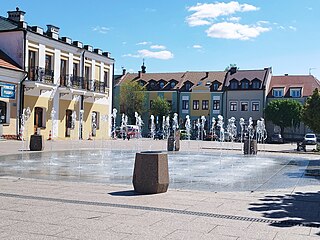
Włodawa is a town in eastern Poland on the Bug River, close to the borders with Belarus and Ukraine. It is the seat of Włodawa County, situated in the Lublin Voivodeship. As of 2016 it has a population of 13,500.

Poniatowa is a town in southeastern Poland, in Opole Lubelskie County, in Lublin Voivodship, with 10,500 inhabitants (2006). It belongs to the historic province of Lesser Poland. During the existence of the 17th-century Polish–Lithuanian Commonwealth Poniatowa was part of the Lublin Voivodeship also. For most of its history Poniatowa was a village; it did not receive town charter until July 18, 1962. The town has a sports club Stal, established in 1951.

Sobibór is a village in the administrative district of Gmina Włodawa, within Włodawa County, Lublin Voivodeship, in eastern Poland. It lies close to the Bug River, which forms the border with Belarus and Ukraine.

Kozłówka Palace is a large rococo and neoclassical palace complex of the Zamoyski family in Kozłówka, Lubartów County, Lublin Voivodeship in eastern Poland.
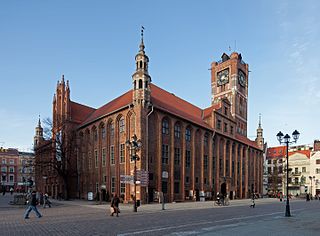
Toruń Regional Museum, located in the Ratusz hall of Toruń, is one of the oldest and largest museums in Poland. It started in 1594 as the mere Cabinet of Curiosities at the library of the academic Gimnazjum, called Musaeum in Latin. Re-established in sovereign Poland as a city museum in 1920 after the century of military partitions, it was administratively structured as the regional museum in 1965.
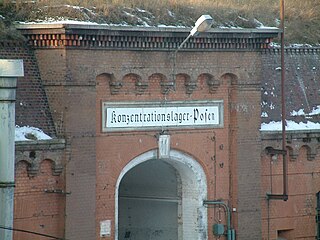
Fort VII, officially Konzentrationslager Posen, was a Nazi German death camp set up in Poznań in German-occupied Poland during World War II, located in one of the 19th-century forts circling the city. According to different estimates, between 4,500 and 20,000 people, mostly Poles from Poznań and the surrounding region, died while imprisoned at the camp.

The Museum of Polish History or the Polish History Museum is a museum and national cultural institute in Warsaw, Poland. The purpose of the museum is to present the most important events in Polish history, with a particular emphasis on Polish traditions of freedom. Since September 2023, the new museum building has been located in the Warsaw Citadel.
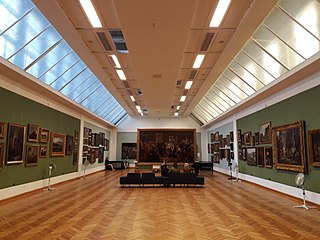
The National Museum in Lublin is one of the oldest and largest museums in Eastern Poland, located in Lublin. It was created in 1914, and received its own building in 1923.

Dagobert Frey was an Austrian art historian, a criminal responsible for the theft of the most valuable European and Polish collections from the Warsaw and Kraków museums and national art galleries during the Nazi German occupation of Poland.
Poniatowa concentration camp in the town of Poniatowa in occupied Poland, 36 kilometres (22 mi) west of Lublin, was established by the SS in the latter half of 1941, initially to hold Soviet prisoners of war following Operation Barbarossa. By mid-1942, about 20,000 Soviet POWs had perished there from hunger, disease and executions. The camp was known at that time as the Stalag 359 Poniatowa. Afterwards, the Stammlager was redesigned and expanded as a concentration camp to provide slave labour supporting the German war effort, with workshops run by the SS Ostindustrie (Osti) on the grounds of the prewar Polish telecommunications equipment factory founded in the late 1930s. Poniatowa became part of the Majdanek concentration camp system of subcamps in the early autumn of 1943. The wholesale massacre of its mostly Jewish workforce took place during the Aktion Erntefest, thus concluding the Operation Reinhard in General Government.

The Majdanek State Museum is a memorial museum and education centre founded in the fall of 1944 on the grounds of the Nazi Germany Majdanek death camp located in Lublin, Poland. It was the first museum of its kind in the world, devoted entirely to the memory of atrocities committed in the network of concentration, slave-labor, and extermination camps and subcamps of KL Lublin during World War II. The museum performs several tasks including scholarly research into the Holocaust in Poland. It houses a permanent collection of rare artifacts, archival photographs, and testimony.

The Sobibór Museum or the Museum of the Former Sobibór Nazi Death Camp, is a Polish state-owned museum devoted to remembering the atrocities committed at the former Sobibor extermination camp located on the outskirts of Sobibór near Lublin. The Nazi German death camp was set up in occupied Poland during World War II, as part of the Jewish extermination program known as the Operation Reinhard, which marked the most deadly phase of the Holocaust in Poland. The camp was run by the SS Sonderkommando Sobibor headed by Franz Stangl. The number of Jews from Poland and elsewhere who were gassed and cremated there between April 1942 and October 14, 1943 is estimated at 250,000; possibly more, including those who came from other Reich-occupied countries.

Szebnie was a forced-labor camp established during World War II by Nazi Germany in the General Government in the south-eastern part of occupied Poland. It was located near the town of Szebnie approximately 10 kilometres (6 mi) east of Jasło and 42 km (26 mi) south-west of Rzeszów. The facility was constructed in 1940 originally as horse stables for the Wehrmacht, adjacent to a manorial estate where the German officers stationed (photo). Over the course of the camp's operation thousands of people perished there, including Soviet prisoners of war, Polish Jews, Poles, Ukrainians, and Romani people. The charred remains of the camp were entered by the Soviets on 8 September 1944.
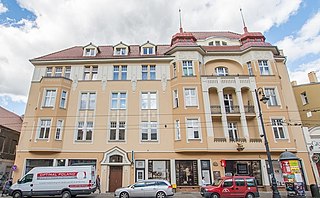
The August Mentzel Tenement is a habitation house located in Gdańska Street, Poland.
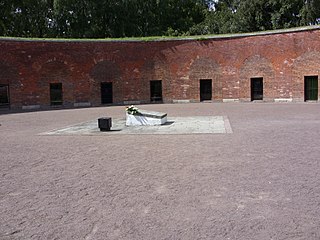
The Rotunda Zamość or the Museum of Martyrdom of the Zamość region - Rotunda, is a Polish museum devoted to remembering the atrocities committed at the former Rotunda Zamość Nazi German camp located in Zamość near Lublin. The Nazi German Gestapo camp was set up in occupied Poland during World War II, as part of the Polish extermination program known as the German AB-Aktion in Poland, Ethnic cleansing of Zamojszczyzna by Nazi Germany....

The Michniów massacre is a massacre that occurred on 12–13 July 1943 in the village of Michniów during German occupation of Poland when approximately 204 of its inhabitants, including women and children, were massacred by German Ordnungspolizei and Schutzstaffel.

The Mausoleum of the Martyrdom of Polish Villages in Michniów is a museum located in Michniów, in Świętokrzyskie Voivodeship, in Poland, constituting a branch of the Museum of the Kielce Village, commemorating the pacification actions in German-occupied Poland.
51°14′48″N22°32′46″E / 51.2468°N 22.5461°E